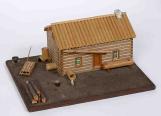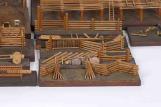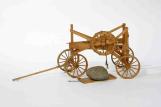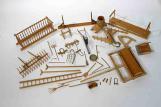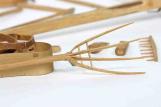2
U.E.L . GROUP OF MODELSMr. McCrea crafted a large group of models that he names the U.E.L. group. After the American Revolution many persons who were loyal to the British crown fled to Canada and became known as the United Empire Loyalists ( U.E.L.) Many came with virtually nothing other than what they could carry. As many of the group had been farmers in the States, they brought with them the knowledge and ability to farm their new lands.
4
U.E.L. HOMESTEADThe simple log home in this model is constructed of logs well chinked to keep out the wind and elements. The log home usually contained only one large room with areas set aside for sleeping and eating. In time, the homes would contain small bedrooms to provide privacy. The main living area centred around the fireplace and kitchen. Squared logs were preferred by the homemaker as they allowed a smoother interior surface.
There is a downspout on the front of the model allowing rainwater to collect in the trough. A large lye basswood log is set upright beside the home and the wood pile is nearby. A small dog is in front of the dwelling.
6
U.E.L. FENCESMany types of early fences are seen in this model. Probably the most commonly constructed fence was the snake fence seen in the lower right foreground. These fences demarcated the boundaries of many of the farms. The settler was obligated in Ontario to mark his boundaries within a set number of years after the land was deeded to him. Other types of fences are shown - the Hurdle fence in the rear, the Five Bar Gate and the Staked and Capped Fence. The fences were often made of raw timber in the early days and then as sawmills became more prevalent, peeled timber and squared timbers would be used.
8
STONING MACHINEMuch of the land deeded to the early settlers was strewn with rocks and when trying to plough the fields, much larger stones were encountered. These had to be cleared away before farming could be undertaken and in fact, before homes could be built. Initially this was done by hand, with large boulders being dug around and often a large fire built on and surrounding the boulder or stone in an attempt to "split" it into smaller pieces. The stone might be removed by manpower and ropes or by employing horsepower.
The stoning machine was a heavy piece of farm equipment pulled by horses. Mr. McCrea had to search out a stoning machine on which to base his model and found one on a farm near Lang, Ontario. The stoning machine would be loaned from farm to farm and would enable the clearing of much more land than previously possible. The stone was lifted by hooks and a chain was placed around it. This was then raised as the horses pulled on the rope around the big wheel. The stones were hauled to a place on the property and you can find these piles of stones along many a fence row or back field of early settled lands.
10
FARM IMPLEMENTSA collection of farm implements was crafted in this collection and the minute size and precise detail of each is noteworthy. Included in these are a grain cradle, forks of various sizes and uses, flails, ladder, roller for smoothing rough ground, and small gardening implements. A unique "seed sewing" implement is included which enabled the user to have his hands free
The grain cradle was based on the one manufactured by one Samuel English who had a shop in Omemee. The following is quoted from the book "Omemee".
"The grain cradle was a device built of light, but strong, wood, which was fastened to a scythe for the reaping of grain by hand. When the farmer cut a swath of grain, the stalks were caught up by the cradle, and when enough was gathered thus, it was tied into a bundle, or sheaf. This, of course, was a method used before the days of the horse-drawn mechanical reaper, which in turn, was the forerunner of the self binder.
The reputation which English's cradle enjoyed may be judged from the following items published in the CANADIAN POST:
"August 17, 1877: FOR THE WORLD'S FAIR - Mr. Samuel English, grain cradle manufacturer is getting very up a very superior article in that line for the Paris Exposition of 1878. This is enterprise of the kind to be encouraged.
"September 19, 1879:CHAMPION CRADLE-MAKER - Mr. S. English of this place is now the acknowledged champion grain cradle-maker in the world. He took first prize at the Centennial, first at the World's Fair in Paris, and this year in Toronto.".
12
HAY FORKA four tine hay fork shows the delicate work undertaken by Mr. McCrea The tines on this item are the thickness of a toothpick and yet are shaped to a point and curved into position with preciseness.
14
SACK OF GRAINA large sack of milled grain sits waiting transport to the horse and wagon that would haul the same to the merchant or to the farm home. These sacks were tied originally with strips of bark and made of a burlap type weave.

